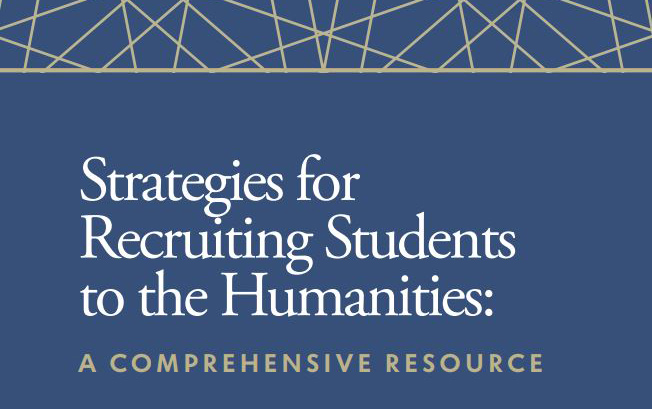NHA's Newest Resource Provides Strategies for Making the Case for the Humanities on Campus
In the context of the financial fallout of the COVID-19 pandemic and the widespread decline in humanities majors and enrollments precipitated by the last recession, faculty and administrators across the humanities are redoubling their efforts to attract more students. Over the past three years, the National Humanities Alliance (NHA) has been researching the field of undergraduate humanities recruitment to identify effective approaches that can be adapted across disciplines and institutional contexts. At the 2021 Virtual NHA Annual Meeting in March, we released Strategies for Recruiting Students to the Humanities: A Comprehensive Resource, which highlights a wide range of strategies through over 100 exemplary initiatives. The report is part of NHA’s Study the Humanities initiative, which, with funding from The Andrew W. Mellon Foundation, supports faculty and administrators in recruiting undergraduates to the humanities.
NHA’s new 80-page resource is grounded in a survey of more than 400 faculty and administrators at over 300 institutions and interviews with project directors of successful initiatives. The report’s four chapters highlight broad strategies that have been effective across a wide variety of institutions: articulating career pathways, curricular innovations, cultivating a marketing mindset, and fostering humanities identity and community. Each chapter presents a wide menu of options to draw upon rather than a prescribed approach. They illustrate the range of approaches with Project Snapshots—brief descriptions of exemplary initiatives—and Voices from the Field—quotes from faculty and administrators about the value of these approaches in different institutional contexts. Impact Research Spotlights highlight key student outcomes through quantitative and qualitative data gathered through our impact research partnerships. Each chapter culminates with in-depth case studies of particularly robust initiatives that offer models for integrating strategies, engaging students, and building partnerships to make initiatives sustainable.
The resource features a number of initiatives undertaken by religion departments and members of the AAR. For example, the Comparative Religion and Humanities Department at California State University, Chico designed an interreligious and intercultural relations certificate to more clearly communicate the value of knowledge of religious traditions for cultivating more constructive relations among members of different religious traditions. There are also lots of pan-humanities initiatives, from collaborations with career services and admissions to interdisciplinary curricular innovations and cohort programs. But there are also dozens of promising initiatives launched from within other humanities disciplines that faculty and administrators might adapt, such as strategies for leveraging social media and student ambassadors to boost marketing efforts and models for courses that integrate career preparation and advanced disciplinary instruction for majors and graduate students. At Western Michigan University, for instance, a successful graduate program in Spirituality, Culture, and Health has given rise to popular undergraduate courses, including Death and Dying, Religion and Health, and Meditation Traditions, which have all filled to capacity.
In this way, Strategies for Recruiting Students to the Humanities serves to complement the efforts of scholarly societies like the AAR to promote their disciplines. We encourage members to use the NHA’s growing Humanities Toolkit resources as well as those provided by the AAR to help advocate for the study of religion to college administrators as well as to students. These strategies for promoting the discipline can be combined with collaborative pan-humanities approaches that address challenges that impact all humanities departments, such as concerns about job prospects, and expand the humanities reach through interdisciplinary programs. The question is, “what makes sense on your campus?”
We are also committed to convening a pan-humanities community of practice around this work through regular opportunities to support one another’s efforts. At the Annual Meeting, we delved into several strategies with 19 leaders of initiatives featured in Strategies for Recruiting Students to the Humanities. In the coming months, we will continue to convene this community through a series of virtual events that will leverage Strategies for Recruiting Students to the Humanities: A Comprehensive Resource to encourage new innovations and initiatives. We hope that you will consider joining us. By learning from one another, we can help revitalize humanities undergraduate education.





